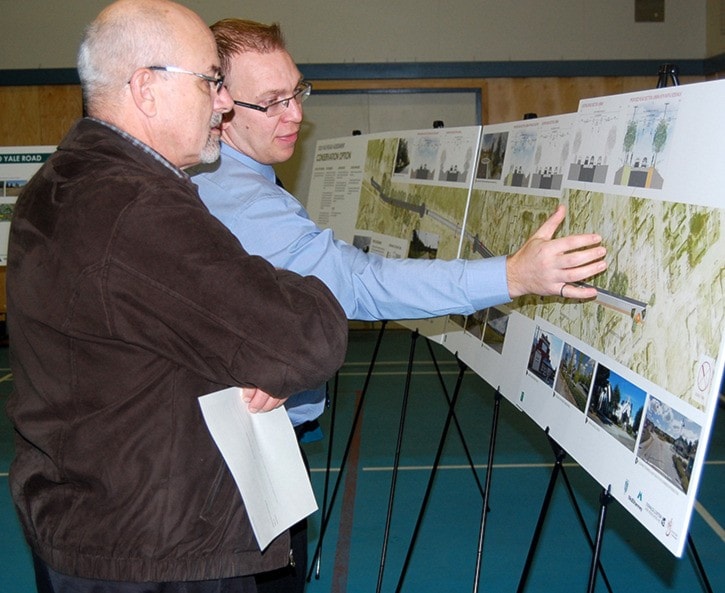Langley's oldest and, arguably, most battered road will likely be getting an upgrade.
But the extent of the repairs — and what form they will take — depends largely on residents' priorities for the concrete road that links 216 Street and the Langley City boundary, near Fraser Highway.
On Thursday evening, the municipality hosted an open house on the future of Old Yale Road. Display boards set up inside the gymnasium of Langley Fundamental Elementary school explained the history of the road and outlined a trio of options for improving it, along with the associated costs and the pros and cons of each plan.
The Township's challenge will be to balance the needs of drivers with those of residents whose property fronts Old Yale, as well as cyclists and pedestrians, all while taking into account the road's heritage status.
Among the options under consideration are A) "Conservation" B) "Commemoration" and C) "Reconstruction."
Conservation of Old Yale would see the least damaged segment of the original road preserved and the reconstruction — using concrete — of the section between the Five Corners roundabout and 214A Street. It would also include the installation of a multi-use path on the north side of the road, which would eventually be connected to the Township's trail network. The estimated cost of the conservation option is $4.3 million.
The commemoration option, at a cost of $4.6 million, would see most of the road rebuilt to modern standards, with a 375-metre section reconstructed in concrete. It calls for a multi-use path to the north of Old Yale Road and the construction of a sidewalk along the south side of the road.
Reconstruction, meanwhile, would see the entire stretch of concrete removed and replaced with asphalt. The new design would include curbs, gutters, marked bicycle lanes and sidewalks on both sides of the road.
This option would cost around $4.4 million, the Township estimates.
The reconstruction option also includes plans to use a portion of the original concrete road as part of an interpretive display.
Visitors to the Nov. 26 open house were invited to look over the presentation and question staff before filling out a survey.
For some residents, preserving the history of Langley's oldest road is paramount, while others would prefer to have a smooth, modern surface linking Murrayville with the rest of the community.
For still others, the main concern is the potential for increased volumes of traffic and drivers speeding along what is presently a relatively quiet country road.
Originally constructed as a dirt path for wagons in the 1870s, Old Yale Road was covered with gravel in 1897. The existing concrete surface west of Five Corners was poured in 1923.
There was some speculation that Old Yale was constructed as a corduroy road, with concrete poured over a bed of logs, laid side by side. However, core drilling showed no evidence of that, said Township transportation engineer Richard Welfing.
More likely, he said, the road was constructed without any underlying reinforcement whatsoever.
While different enough to "tease people apart," in terms of helping them determine their individual priorities, each option contains some degree of attention to the road's historic value, said Elaine Horricks, heritage planner for the Township.
The stretch under consideration is, in fact, the last remaining section of the road — which originally linked New Westminster and Yale, in the Fraser Canyon — that maintains its original concrete panels.
Linking Five Corners to the larger Township trail network is another priority, said Horricks.
"(We want to) make the corridor more vibrant from a pedestrian and cyclist point of view."
Each option has both its advantages and drawbacks, Township staff acknowledged.
The disadvantage of both options B and C is that a smoother road will inevitably lead to more and faster traffic, Horricks said.
Brian Holmes, a Fort Langley resident who uses Old Yale Road infrequently — but more often since the City installed a traffic light at Fraser Highway — acknowledged that the presentation led him to rethink his original position.
He said he arrived at the open house convinced that Old Yale Road should simply be paved, so that drivers can get better use out of it.
"But I understand now what that would do to Five Corners," he said.
Residents will be given three weeks to offer feedback to the Township.
Details of the three options can be viewed on the Township of Langley website. Once public feedback has been received it will be compiled and presented to council.
